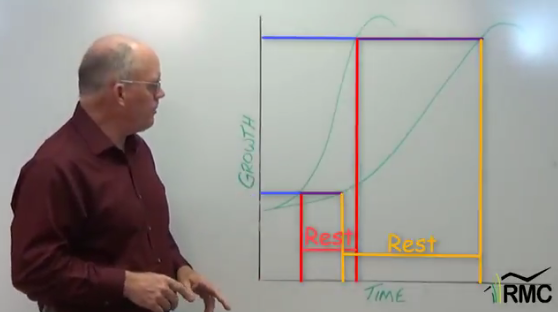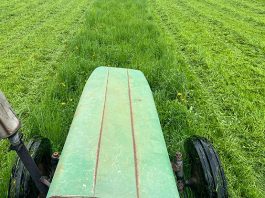

If you’re looking over at the remains in your neighbor’s crop residue or cover crops and are seeing potential forage, you’ll like this two-part series. It will give you some ideas and tips for creating a win-win opportunity. You feed your livestock while improving soil health and productivity for your neighbor!
Thanks for this series goes to the Beef Cattle Research Council of Canada.
Grazing cattle on neighboring farmland can have benefits to both the cattle producer and the farmer if done properly. From Saskatchewan to Manitoba and Ontario the following producers have had success with grazing cattle on neighboring crop land.
Leanne Thompson and Tannis Axten are neighbors in southeastern Saskatchewan. The Thompsons own and operate a cow-calf and backgrounding operation with 500-800 head of mother cows as well as backgrounding cattle. The Axten family owns and operates a 6,000 acre grain farm that is highly diverse, focusing heavily on soil health and intercropping. Both operations have experienced mutual benefits by arranging to have the Thompsons’ cattle graze stubble and cover crops on the Axtens’ landbase.

Joey Bootsman is a cow-calf producer near Brandon, Manitoba where, along with his family, he calves 600-700 cows, as well as manages backgrounding and grass cattle, and raises bred heifers for sale. The Bootsmans grow most of their own feed but will send cattle to community co-op pastures or other rented pastures in the summer. Bootsman works with his neighbors to graze his cows on their stubble fields when they come home from summer pasture to carry cattle through the fall.
Adam Shea and his family have a beef, sheep, and cash crop operation in east central Ontario. They are located in a very diverse agricultural area that includes ideal cash crop acreage next to hilly areas that are suitable only for grazing cattle. Shea really liked the idea of grazing cover crops but his uncle and father who run the cash crop side of their operation were not so sure. Shea was able to work out a deal with his neighbor to graze cover crops after winter wheat was harvested.
Although all of these producers have a unique story when it comes to working with their neighbors, some common themes emerged.
Communication is Key
All four producers reiterated that clear communication up front was key. While some sit down together and draw up an official contract, others keep things more informal with verbal communications. All agree that making sure everything is talked about early on makes the partnership much smoother. It is important to leave no assumptions on the table. Even things as simple as who will be looking after the cows, fence, and water should be discussed to make sure both parties are on the same page.
Infrastructure is a key communication piece, and often where things get a little tricky. Farmers don’t need or often want permanent water and fencing but having access to those is needed to graze cattle on cropland. Shea and Bootsman combatted this by using temporary electric fence and water troughs and maintaining clear communication about when it would be taken down. It was also important to identify who is responsible for setting it up and taking it down by the agreed upon date.
“It really comes down to trust,” says Axten. “Once you have communicated clearly and the cattle are out on the land you have to trust both parties will make the right decisions.” Axten also recognizes that although it’s easy to want different things than your neighbors, such as more frequent cattle moves, there is also a practical limit to their ability, so it is important to reach a compromise that is manageable for both parties.

For Shea, since he is relying on cover crops as a source of feed, he says it is necessary to treat them like a forage crop, and in his area that means ensuring nitrogen fertilizer is applied. The discussion of who is seeding cover crops, who is paying for them, when they are being seeded, when nitrogen is applied, and who is paying for nitrogen application is all discussed the previous year.
When it comes to convincing cropping neighbors it is a good idea to graze cattle on their land, doing it right the first year is key. “You can usually find someone willing to try it once,” says Bootsman. “If you communicate well and continue to be a good steward of the land, they are more likely to want to work with you in the future.”
Assign Value
With proper planning ranchers and farmers can work together to provide a mutually beneficial system. Crop farmers can use cows to terminate fall cover crops, receive some post-harvest income, and positively impact soil health, while beef producers can get additional grazing without buying or renting land.
“Feed isn’t free,” says Thompson. “It’s important to assign value to services provided by both sides even if no money is actually changing hands.” Assigning value to all aspects of the partnership, whether it is grazing time, soil health, or fence construction, allows both parties to understand what they are getting out of the deal. Thompson was clear that cattlemen can’t approach the arrangement with an attitude that the farmer wasn’t using it anyway so there is no value. Having a value assigned assures both parties are comfortable with what is happening and that everyone gets the most out of the arrangement.
Shea is upfront with his neighbor to make sure both parties see value from the outset. “This only works if they feel they are getting something out of it as well.”
For Bootsman the valuation is also clear up front. In his area he pays $500-$1,000 per quarter section for grazing land. Since it is revenue the farmer would not have otherwise received at that time it helps to ensure that he has stubble to graze.
Good Fences Make Good Neighbors
Infrastructure like fencing and water is necessary to graze cattle on crop land and often must be installed before grazing can take place. Adequate fencing will ensure cattle stay where they are supposed to which is crucial for success and a better chance of being invited back to graze again in future years.
 For Bootsman and Shea, temporary electric fencing is the solution. Both use a single wire fence (Bootsman uses two wires near a highway) but both emphasize that this only works when cattle have already been trained to an electric fence. Both then remove the electric fence shortly after grazing so it isn’t in the farmer’s way.
For Bootsman and Shea, temporary electric fencing is the solution. Both use a single wire fence (Bootsman uses two wires near a highway) but both emphasize that this only works when cattle have already been trained to an electric fence. Both then remove the electric fence shortly after grazing so it isn’t in the farmer’s way.
The Axtens had some permanent fencing, but it needed repairs and rebuilding. They worked out an agreement with Thompsons where they purchased the supplies and Thompsons provided the labour to put it up.
Portable watering systems have been used by all producers. Shea says being flexible is key, since he only grazes on cover crops after winter wheat has been harvested and he rotates the fields he uses every year. In some years he has been close enough to the yard to simply run a hose and in other years has had to haul water.
Thompsons have also relied on portable watering systems, but occasionally get lucky and are able to tie on to water lines from their own property if grazing land is nearby. For fall and winter grazing, they tend to rely on dugouts or snow for a water source while cattle are on Axten’s cropland.
Stay tuned for more! Part 2 will cover cattle management – knowing when to move them based on conditions, and using the right class of animal to match nutritional needs with what is available.
Webinar!
Cover Crops in Corn Systems: Opportunities for Dual Use
 September 15 – 7:00 to 8:30 pm CDT
September 15 – 7:00 to 8:30 pm CDT
Can planting cover crops in corn systems provide the dual benefits of improving soil health and be an economical source of forage? This webinar will cover lessons learned on incorporating cover crops after corn silage, high moisture corn, and dry corn harvest in Nebraska. The session will consist of short presentations with ample time for questions and discussion.
The webinar is free but you must register. Learn more here.



